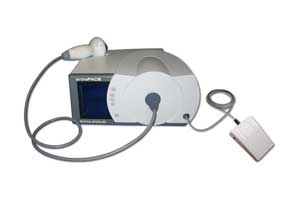orthoPACE

SANUWAVE has a long and successful history in treating bone conditions requiring osteogenesis, calcific joints, conditions causing painful joints, treating chronic pain caused by musculoskeletal disorders. orthoPACE is the latest device offered by SANUWAVE to effectively treat these conditions.
Indications
orthoPACE is CE Marked for the application of pulsed acoustic waves for the stimulation of osteogenesis and for the treatment of painful bone near soft tissue, e.g.
- Tendinosis calcarea (calcified shoulder)
- Shoulder tendinosis with or without calcification
- Epicondylitis (tennis or golfers elbow)
- Fasciitis plantaris (with or without heel spur)
- Achillodynia (achilles tendonitis)
- Patellar tip syndrome
- Bursitis trochanterica calcarea (hip bursitis)
- Acute, delayed-union or non-union extremity fracture
- Osteoarthritis
- Adjunctive use
What are the Expected Results?
ESWT has been proven to be effective after only one treatment. Some patients report immediate pain relief after the procedure, although it can take a few weeks for pain relief to begin. If pain relief is not adequate, then a second treatment can be considered.
Is it Safe?
Yes. Shockwave treatment was originally developed for the treatment of kidney stones over 30 years ago. A wealth of medical experience, state-of-the-art engineering and optimal quality have been built into the orthoPACE device, and extensive clinical studies and tests have confirmed its safety and efficacy.
Why Consider Non-Invasive ESWT with the orthoPACE?
- ESWT with the orthoPACE device has a proven success rate that is equal to or greater than that of surgery – usually with just one procedure and without the inherent risks, complications and lengthy recovery time of invasive surgery
- ESWT with the orthoPACE requires a minimal amount of time and patients can go home the same day the procedure is performed
- Patients can bear weight immediately, and return to normal activity within a few days of the procedure
- ESWT treatment is a non-invasive procedure so there is no risk of infection and scarring
- Preserves any future treatment options
What Will Happen the Day of the Procedure?
Your doctor or healthcare facility will commonly ask you to arrive at the office or facility before your scheduled procedure. It is recommended that you wear loose-fitting clothing. You may be asked to change into a hospital gown. The staff may take your temperature, pulse and blood pressure, and ask some questions about your general health. Prior to administering anesthesia, the physician may palpate (touch) the area to determine the area of maximum tenderness (target area) and mark the area with a surgical marking pen. Further imaging of the area may occur if needed. The procedure can cause some discomfort or pain, so anesthesia may be given before the procedure.
High viscosity gel is applied to the area previously marked with the surgical marking pen (target area). The gel promotes shockwave conductance, enhancing the treatment’s effectiveness.
What Will Happen After the Procedure?
You will stay at the hospital or facility until the anesthetic wears off enough to move about safely. You will receive post-operative instructions from your physician to follow during your recovery.
What are Possible Side Effects/Complications?
The non-invasive procedure with the orthoPACE has minimal risks. In some cases it can cause skin reddening, bruising, tingling or numbness. Directly after treatment there may be a brief increase in pain. Some patients have reported a recurrence or episodes of pain following the procedure, which may continue for a few days to several weeks. It is also normal to have some residual pain after intense exercise.
What if I have a Special Health Condition?
The safety and effectiveness of ESWT procedures has not yet been determined in people with the following health conditions. Your doctor will provide you with information about how these and other health conditions might affect the outcome of an ESWT procedure.
- Patients with anatomical anomalies in the treatment area
- Acute inflammations in the treatment area
- The presence of a cuff rupture in treatments of the shoulder
- Malignancies in the treatment area
- Treatments in the head area
- Treatments on the spinal column
- Treatments in the lung area
- Treatments in the area of the gonads
- Coagulation disorders
Little or no experience has been gathered in cases of:
- Children
- Pregnant patients
- Patients with pacemakers
- Patients with implants in the treatment area
How Can I Get More Information?
Your doctor is the best person to talk with if you have questions or concerns about the ESWT procedure. He or she has extensive knowledge and specialized training on all aspects of its use, safety, and effectiveness.
